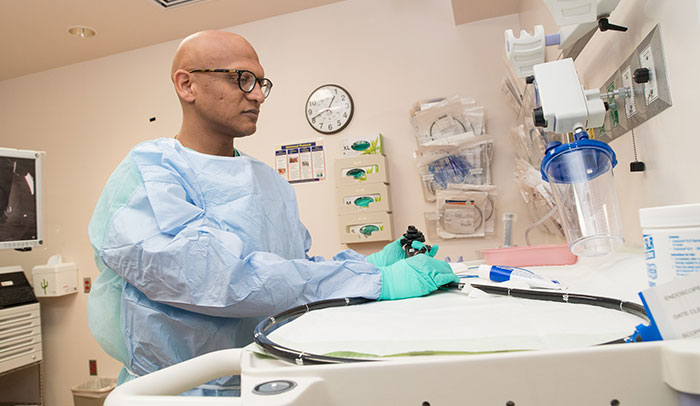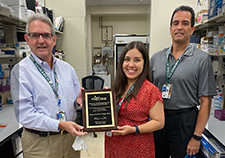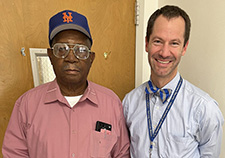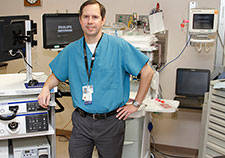Office of Research & Development |
 |


Dr. Samir Gupta, chief of gastroenterology at the VA San Diego Healthcare System, is leading the VA Colonoscopy Collaborative. (Photo by Christopher Menzie)
February 21, 2019
By Mike Richman
VA Research Communications
How can VA reach peak efficiency in preventing colorectal cancer, the second-leading cause of cancer deaths in the United States?
That question is dominating the thinking of a number of VA clinicians and researchers, including Dr. Samir Gupta, the chief of gastroenterology at the VA San Diego Healthcare System.
Gupta is leading the VA Colonoscopy Collaborative, a framework for promoting epidemiological research and quality improvement. The ultimate aim is to optimize the effectiveness of colonoscopies in VA, and thereby maximize Veterans’ health outcomes.
Specifically, Gupta is focused on improving VA guidelines in two areas. One is the minimum percentage of patients in whom doctors should spot pre-cancerous polyps. The other is how soon patients with polyps should return for a follow-up colonoscopy. Pre-cancerous polyps are abnormal growths in the colon or rectum that could become cancerous. The most common type of pre-cancerous polyp in the colon is an adenoma.

VA center training the next generation of researchers in blood clots and inflammation

AI to Maximize Treatment for Veterans with Head and Neck Cancer

VA researcher works to improve antibiotic prescribing for Veterans

Veterans help find new cancer treatments
VA lacks internal guidelines for both figures. Instead, VA gastroenterologists and other clinicians follow screening recommendations from the U.S. Multi-Society Task Force (MSTF) on Colorectal Cancer, which represents the American Gastroenterological Association, the American College of Gastroenterology, and the American Society for Gastrointestinal Endoscopy.
The task force says doctors should find adenomas in at least 30 percent of male patients, at least 20 percent of female patients, and at least 25 percent of patients overall (see sidebar). In the case of follow-up colonoscopies, the MSTF recommends a return within a time period ranging from a few months to as long as 10 years, based on the number and size of pre-cancerous polyps found in the initial screening, as well as family history.
Through their research, Gupta and his team aim to show how VA doctors and facilities are differing in the percentage of patients in whom they find adenomas, and what bearing those numbers have on the likelihood that a Veteran may get cancerous polyps after initial polyp removal. “We’ll be able to show people what the consequences are for the colonoscopist who’s a 25 percent detector versus a 35 percent detector versus a 45 percent detector,” Gupta says.
He says the findings may also guide new minimum standards on colonoscopy screening in VA, noting that those suggestions will be released later this year. The findings may also contribute to new VA policies and recommendations, he notes.
To reach their findings, Gupta and his team are leveraging data from VA’s electronic medical records, or the Computerized Patient Record System (CPRS). Thus far, they’ve collected information on Veterans who have undergone a colonoscopy in VA medical centers from 1999 to 2016. (VA is in the process of aligning CPRS with the Department of Defense’s electronic medical records system to allow for seamless care between the agencies.)
According to an article by Gupta’s team that appeared in April 2018 in the online journal eGEMs (The Journal for Electronic Health Data and Methods), the data include 2.3 million Veterans who had at least one colonoscopy in VA from 1999 to 2014. The cohort had a median age of 62, and nearly all of the Veterans were male. The researchers estimate that 2.6 percent of the Veterans had a diagnosis of colorectal cancer in their initial colonoscopy, and that an additional 1 percent were diagnosed on follow-up. Analysis of the final two years of data is ongoing.
"With the help of the Colonoscopy Collaborative, we hope to identify opportunities for moving lower-performing physicians and facilities to higher detection rates."
Preliminary findings, Gupta says, are pointing to the need for a higher standard percentage for adenoma detection in the VA patient population. Thus far, the researchers have spotted a lot of variation in the data, with adenoma detection rates ranging from less than 20 percent to more than 50 percent among VA doctors performing colonoscopies.
“We’re finding a greater risk for getting cancer in the three-year period after a colonoscopy among patients with low-scoring colonoscopists versus the high-scoring,” says Gupta, who is also an associate professor at the University of California, San Diego. “Essentially, we think those are missed cancers. The amount of times a doctor finds a pre-cancerous polyp appears to be a marker of how carefully that person is doing the exam. This puts a lot of pressure on us to think about how we’re going to fix this. How are we going to make it so people perform better?”
The research will allow Gupta and his team to better inform VA clinicians where they should stand in terms of finding pre-cancerous polyps and why they should try to do better.
“Right now,” Gupta says, “if someone said, 'My rate is 35 percent. Am I under- or over-performing?’ We’d say, 'By the best standards that are set up, you’re doing fine.’ But our research may help inform whether that’s the right target, and whether the standard should be higher in VA than it is for other populations based on the outcomes that are occurring in patients due to the performance of their doctors. A person who’s doing 35 percent might say, 'I’m meeting the metric, why should I try to get better?’ If we can show that the outcomes for people who are at 45 percent or 50 percent are even better, that may inspire colonoscopists to want to improve their performance.”
When assessing risk for colon cancer, clinicians most often tell a patient to return in three, five, or 10 years for another colonoscopy, depending on the size and number of adenomas found in the initial screening, says Gupta. He adds, however, that VA’s current approach to assigning follow-up visits is “imprecise.”
“One of the reasons we received a VA Merit Review award was to come up with new prediction strategies,” he says. “We want to look at not only the number and size and type of polyps that people have, but also look at quality factors like polyp detection rate. How good was the bowel prep? How cleaned out was the colon? Was the exam complete to the end of the colon? Let’s use these additional factors to come up with a more precise way of predicting risk. The implication is that if we can better tell who’s at high risk and who’s at low risk, then we can provide people with more appropriate follow-up recommendations—maybe three years for people we think are at higher risk, and let people who are at very low risk go longer, to 10 years.”
The U.S. Multi-Society Task Force on Colorectal Cancer recommends follow-up dates for colonoscopies based mostly on the size and number of adenomas found in a first-time screening:
Excluding skin cancers, colorectal cancer is the third-most common cancer diagnosed in men and women the U.S. It’s also one of the most preventable forms of cancer. Incidence and death related to colon cancer can be significantly reduced by the detection and removal of pre-cancerous polyps and the cancer itself.
There’s no conclusive evidence that Veterans have higher rates of colorectal cancer than the general population. But Gupta believes that’s the case. And he suggests it’s why the average standard for detection may need to be higher in VA.
“For most gastroenterologists who work at VA, it’s our clinical impression that on average Veterans have more polyps than other groups of people that we care for,” he says. “That’s my impression, as well. I don’t think we’ve clearly understood why the rate among Veterans may be higher. Is that just due to risk factor exposure, such as smoking? Whether it could have something to do with military service has not been well-studied.
“I haven’t seen data showing that colon cancer rates are higher in Veterans,” he adds. “But that is confounded by the fact that VA does a very good job of getting Veterans screened for colon cancer. The screening rate [in VA] is more than 80 percent. We really get ahead of the national rate.”
Less than 70 percent of Americans ages 50 to 75 are believed to be receiving proper colorectal cancer screening.
Colonoscopy has long been considered a good screening method for the prevention and early detection of colon cancer. The test evaluates the entire colon, a tube-like organ that extends from the end of the small intestine to the rectum and removes water from digested food, among other functions. Up to 10 percent of adenomas can become cancerous within a decade-long period if they are undetected or ignored. The American Cancer Society suggests that colon cancer screening should begin at age 45.
Research has shown that colonoscopies performed by gastroenterologists have a much higher rate of polyp detection than those done by other clinicians because of their special training.
The vast majority of colonoscopies in VA are completed by gastroenterologists, followed by surgeons, especially colorectal surgeons. Some primary care physicians who specialize in internal or family medicine also perform colonoscopies.
According to Gupta, it’s too early to speculate whether cases of lower polyp detection in VA are linked in any way to the fact that some non-gastroenterologists are performing colonoscopies.
The other popular screening test for colon cancer is the noninvasive fecal immunochemical test (FIT), in which a small sample of feces is collected by the patient at home. The sample is checked in a lab for small amounts of blood, a potential warning sign of developing cancer.
Currently, VA researchers are conducting a large multisite study to assess whether colonoscopy or FIT is better for curbing colorectal cancer incidence and death. The study, known as CONFIRM, has enrolled more than 50,000 Veterans, making it the largest single VA clinical trial ever. The 10-year follow-up phase is now ongoing.
Dr. Jason Dominitz is co-chair of CONFIRM and is VA’s national program director for gastroenterology. He believes the first step to assuring that Veterans have access to high-quality colonoscopy is to reliably measure colonoscopy results. Data from CONFIRM have shown a much higher average adenoma detection rate in VA than the current 30 percent benchmark for men, he notes.
“With the help of the colonoscopy collaborative, we hope to identify opportunities for moving lower-performing physicians and facilities to higher detection rates,” says Dominitz, who is with VA Puget Sound in Washington state. “It’s important to note that the quality of colonoscopy depends on far more than just the skills of the doctor. It also depends on a well-organized system to schedule and educate patients on the procedure in order to reduce late cancellations, no-shows, and inadequate bowel preparation.”
Gupta says he’s a big supporter of the CONFIRM trial, noting that the San Diego VA was a local site for the study.
“The CONFIRM study is about people who are at average risk for colon cancer and are undergoing routine screening,” he says. “The question is, how does FIT perform compared with the more invasive strategy of a colonoscopy, which should be more sensitive for picking up cancers and polyps? Our research really focuses on the back end of that. So when a person has an abnormal FIT and then has a colonoscopy and has polyps, or when patients have a screening colonoscopy and polyps are found, how do we determine their risk and when do we decide to bring them back?”
Gupta feels the VA Colonoscopy Collaborative has the potential to be a “model for the country.”
“It’s a difficult conversation to point out to people that they’re underperforming,” he says. “But we need to be brave enough to do it because it’s important for patient care. Hopefully, we can then see a positive impact on Veterans. I hope to see this through. This is one of the reasons I really enjoy working at VA. You have opportunities to do big things like this.”

Dr. Erik von Rosenvinge is chief of gastroenterology for the VA Maryland Health Care System. (Photo by Mike Richman)
Dr. Erik von Rosenvinge is the chief of gastroenterology for the VA Maryland Health Care System. He and his colleagues at the Baltimore VA perform more than 2,000 colonoscopies per year, most of which are on male Veterans.
Von Rosenvinge says all VA clinicians who do colonoscopies should strive to achieve high detection rates of pre-cancerous polyps, which are known as adenomas (see main story). He estimates that his team is finding adenomas in 40 to 50 percent of its patients.
“When you look at adenoma detection rates that have been described in VA medical centers, they’re consistently higher than the traditional cutoffs of 20 percent for women and 30 percent for men,” he says. “At the Baltimore VA, we tend to find higher rates of polyps in Veterans, and as a result believe we should likely have higher standards and expectations. If the Veteran population has increased rates of polyps, then you’re presumably missing polyps if you’re just meeting national targets.”
“If you’re not meeting the 20 percent, 30 percent targets in the VA population, I would say you’re an outlier,” he adds. “It would make sense to identify doctors that are meeting those targets but just barely, which is probably not good enough in our population.”
Von Rosenvinge “suspects” that some VA clinicians aren’t looking closely enough for polyps when they do colonoscopies. The use of non-gastroenterologists for colonoscopy at some VA medical centers could be contributing to that problem, he says. His team at the Baltimore VA includes eight gastroenterologists, an experienced colorectal surgeon, and a general surgeon who completed a specific surgical endoscopy fellowship after his general surgery training.
“Most studies have suggested that gastroenterologists perform better and have higher adenoma detection rates than non-gastroenterologists, although the less-skilled colonoscopy might still be superior to no colonoscopy,” he says. “But there are some realities. You take a rural state like Montana. I believe one person performs colonoscopies in that entire state for VA. And we don’t know that patients going out in the community are getting better care. In fact, evidence suggests they do not.”
In terms of community care, von Rosenvinge points to a 2016 study that included 409 Veterans who underwent colonoscopies at 30 non-academic and two academic facilities through the Veterans Choice Program. The program allows former service members to receive VA-funded care at non-VA facilities in some circumstances. The researchers found that at least one adenoma was detected in 38 percent of the Choice patients, compared with 52 percent of patients who had colonoscopies in VA.
Gastroenterologists performed all of the colonoscopies at VA sites, where the average number of detected adenomas per procedure was 1.41. Gastroenterologists and surgeons did the screening at non-VA facilities, averaging 0.73 adenomas per procedure.
The 409 Veterans who underwent colonoscopies outside the VA were matched one to one to another group of 409 Veterans who underwent colonoscopy procedures at the White River Junction VA Medical Center in Vermont.
Although colonoscopy has long been a popular method for first-time colon cancer screening, von Rosenvinge believes the best approach is to give Veterans the option of a colonoscopy or the non-invasive fecal immunochemical test (FIT). FIT calls for checking once a year for hidden blood in the stool, which can be an early sign of colon cancer, and is much more accurate than the prior fecal occult blood tests, or “stool cards,” he says. The latter involved three different tests over three days and had dietary recommendations that FIT doesn’t have.
Von Rosenvinge is a local site investigator for the CONFIRM study, a VA trial that is assessing whether colonoscopy or FIT is better for preventing death from colon cancer.
“There are certain doctors who say, 'You’re due for a colonoscopy. I’m going to send you for a colonoscopy,’ without having a real discussion with the patient,” von Rosenvinge says. “But some Veterans and non-Veterans just say to themselves, 'There’s no way I’m going to have a colonoscopy. I don’t want to do it. I don’t want to do the clean-out. I don’t want anyone touching my butt.’ So they put it off and never do it and don’t get screened. However, if FIT is offered, they may very well complete it.”
“If you do FIT and it’s positive, the chance is about 1 in 20 that you have cancer,” he adds. “Then you say, 'There’s a 1 in 20 chance I have cancer, so I’m going to do a colonoscopy now.’ So you give people options up front and let them choose which approach is best for them. As they say, 'The best test is the test that gets done.’”
--- Mike Richman
VA Research Currents archives || Sign up for VA Research updates